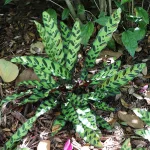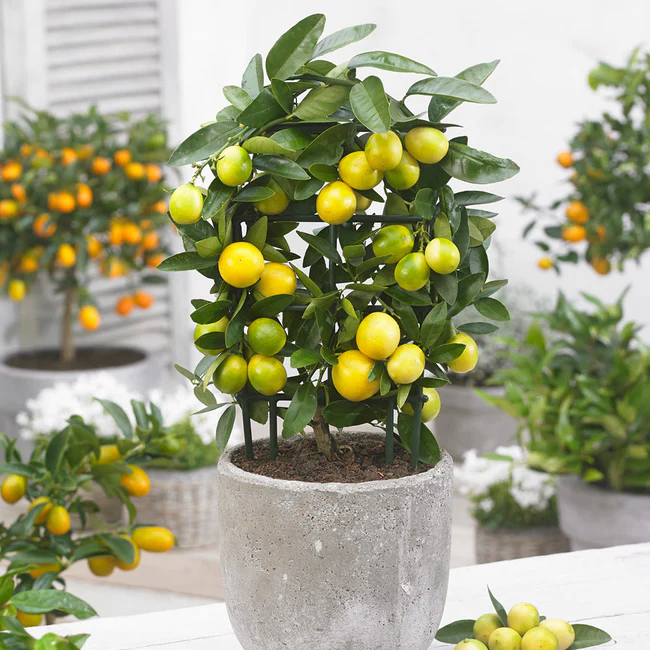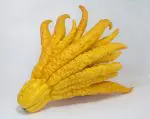This post contains affiliate links. If you buy something from one of our links we may earn a commission. Thanks
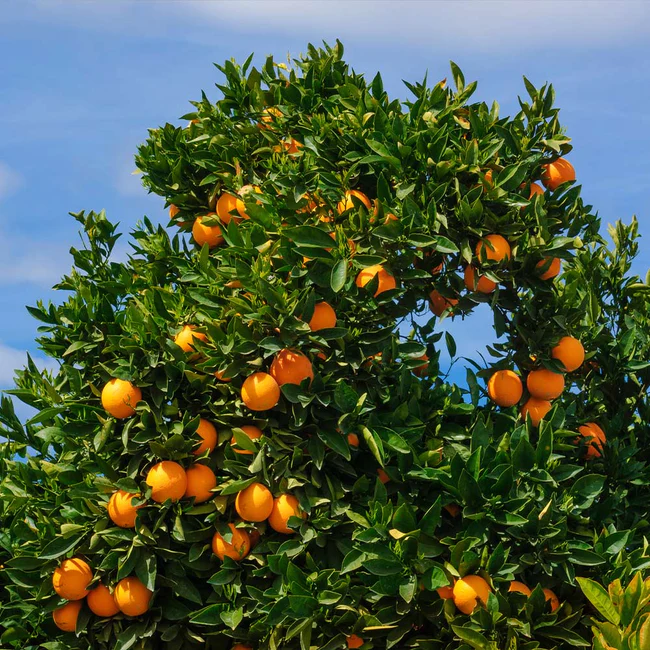
Cara Cara Oranges are a delicious and nutritious fruit that can be grown indoors with proper care.
Cara Cara Orange tree indoor care involves selecting a suitable location considering soil type and sun exposure, planting the tree with proper soil preparation and watering, ensuring good lighting, pruning and training the tree, adhering to a fertilization schedule, regular watering based on the tree’s needs, and managing pests and diseases
If you’re looking to bring the taste of fresh sweet oranges into your home, a Cara Cara Orange tree is a great option. They are also called red-fleshed navel oranges.
These trees are small and compact, making them perfect for growing in pots indoors.
With a little bit of knowledge and effort, you can have a thriving Cara Cara Orange tree in your home, producing juicy and sweet fruit all year long.
This blog post will outline the steps you need for Cara Cara Orange tree indoor care, including tips for planting, watering, fertilizing, and controlling pests and diseases.
Whether you’re a seasoned indoor gardener or just starting out, these tips will help you get the most out of your Cara Cara Orange tree.
What Is A Cara Cara Orange Tree?
Cara Cara Oranges are a unique variety of oranges that are known for their sweet and juicy flavor. These oranges are becoming increasingly popular among gardeners and fruit lovers alike, and for good reason.
Why Cara Cara Orange Trees are popular
Cara Cara Oranges are becoming increasingly popular for a number of reasons. One of the main reasons is their sweet and juicy flavor, which is a refreshing change from the sometimes tart and sour flavor of other types of oranges.
Additionally, Cara Cara Oranges are relatively easy to grow, making them a great option for those who are new to gardening or just looking to add a new fruit tree to their collection.
Cara Cara Oranges are a type of navel orange that is prized for its sweet and juicy flavor. They are named for the pinkish-red color of the fruit’s flesh, which sets them apart from other types of oranges.
Cara Cara navel orange vs Blood Orange
Cara Cara Navel Oranges and Blood Oranges are both varieties of citrus fruits that are prized for their unique flavors and appearances.
Cara Cara Navel Orange is a type of navel orange that is known for its sweet and juicy flesh with a hint of raspberry flavor.
The fruit has a bright red-pink hue, which comes from high levels of lycopene, an antioxidant found in many red and pink fruits.
Blood Orange, on the other hand, gets its name from its distinctive deep red flesh. It has a tart and sweet flavor, with a more complex and intense taste than regular oranges.
The color of the flesh comes from anthocyanins, a type of antioxidant that gives red and purple fruits their color.
Both the Cara Cara Navel Orange and the Blood Orange are popular for their unique flavors and appearances and make a great addition to any fruit platter or recipe.
They Are Related But Different
The Cara Cara Navel Orange and Blood Orange are related as they are both types of oranges. Cara Cara Navel Orange is a type of navel orange, while Blood Orange is a separate variety of orange.
They belong to the citrus family and share many similarities in terms of growth habits and care requirements.
However, they are distinguishable by their unique flavors, appearances, and nutritional profiles.
The scientific name for Cara Cara Navel Orange is Citrus sinensis. The scientific name for Blood Orange is Citrus sinensis var. sanguinea.
Citrus sinensis is the scientific name for the sweet orange, and var. sanguinea refers to the specific type of sweet orange that is known as the Blood Orange.
This naming convention is used to distinguish between different varieties of the same species.
Whether you prefer the sweet, juicy flavor of the Cara Cara Navel Orange or the tangy and complex taste of the Blood Orange, both varieties are delicious and healthy choices for your fruit needs.

Cara Cara Orange Tree Indoor Care 7 Easy Steps For Beginners
Caring for a Cara Cara Orange Tree begins with choosing the right location. The location you choose will play a crucial role in determining the health and productivity of your tree, so it’s important to take the time to consider a few key factors.
Step 1: Choose the right location
In this section, we’ll cover the factors you need to consider when choosing a location for your Cara Cara Orange Tree, including soil type and sun exposure.
By following these guidelines, you’ll be well on your way to growing a healthy and productive tree.
Factors to consider when choosing a location
When choosing a location for your Cara Cara tree, there are several factors that you need to consider.
First, if planting outdoors you’ll want to choose a location that has well-draining soil. Cara Cara Orange Trees are sensitive to waterlogged soil, which can lead to root rot and other problems.
Additionally, you’ll want to choose a location that is protected from strong winds, which can damage the tree and make it more susceptible to disease.
If you are growing it indoors like most of us you will have much more control over these factors.
Soil type
Cara Cara Orange Trees thrive in well-drained soil that is rich in organic matter and has a pH between 6.0 and 7.0.
Sun exposure
Cara Cara Orange Trees need full sun exposure in order to thrive. Outdoors they can tolerate some partial shade.
They should be planted in a location that receives at least 6 hours of direct sunlight per day during the growing season.
Indoors a south-facing window is a good choice.
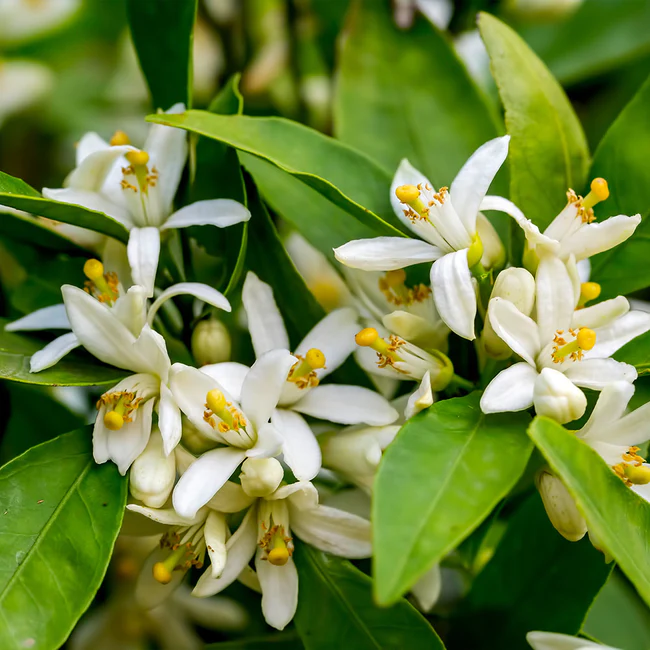
Step 2: Planting the Tree
Growing a Cara Cara Orange Tree indoors is a great way to bring the taste of fresh oranges into your home.
Most of us don’t live in a climate where it can be grown outdoors year-round but fortunately for us, this orange tree does well in containers.
With the right care and attention, your indoor Cara Cara Orange Tree can thrive and produce juicy and sweet fruit all year long.
In this section, we’ll cover the steps you need to take to plant and care for your indoor Cara Cara Orange Tree, including soil preparation and watering requirements.
How to plant the tree
To plant your indoor Cara Cara Orange Tree, you’ll need a container that is large enough to accommodate its root system.
Choose a container that has adequate drainage holes to prevent waterlogged soil. Fill the bottom of the container with a layer of rocks or gravel to improve drainage, and then add a high-quality potting mix.
Place the tree in the container and backfill it with the potting mix, being careful not to bury the tree’s crown (the area where the stem meets the roots).
Give the pot a deep watering to remove any air pockets and be sure to choose a location with adequate light and temperature.
In a few years, you will want to transplant it into a larger pot.
Soil preparation
When preparing the soil for your indoor Cara Cara Orange Tree, it’s important to choose a high-quality potting mix that is rich in organic matter.
Avoid using heavy soil mixtures that can become waterlogged and lead to root rot in small trees. Instead, choose a potting mix that is light and well-draining, such as a mixture of peat moss, vermiculite, and perlite.
You can buy a soil mix specifically for citrus plants. You can also make a good soil mix using 50/50 coco coir and perlite.
Watering requirements
Cara Cara Orange fruit trees grown indoors require consistent watering to keep the soil moist, but not waterlogged.
Water the tree whenever the top inch of soil feels dry to the touch, and be sure to empty any saucers or trays that collect water underneath the container to prevent water from sitting around the roots.
Overwatering is one of the most common problems faced by indoor Cara Cara Orange Trees, so be careful not to overdo it.
By following these guidelines, you’ll be well on your way to growing a healthy and productive indoor Cara Cara Orange Tree.
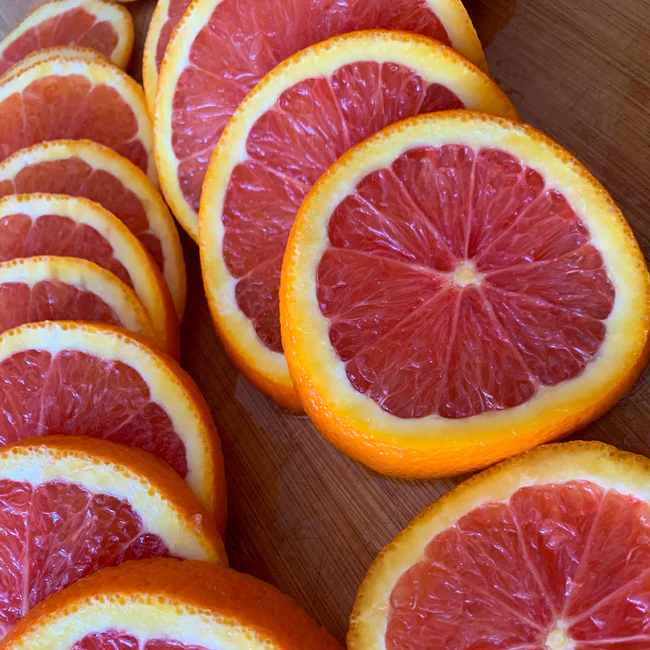
Step 3 Importance of Lighting for Indoor Citrus Plants
Light is essential for plants to grow and thrive. Without adequate light, plants will struggle to photosynthesize, resulting in stunted growth, weak stems, and yellowing leaves.
Indoor plants generally will require some artificial lighting to supplement natural light when it’s not available or very low during the winter months.
Different Types of Lighting for Indoor Plants
There are several types of lighting that can be used for indoor plants, including natural lighting, artificial lighting, LED lights, fluorescent lights, and high-intensity discharge (HID) lights.
Each type has its own advantages and disadvantages, and the right lighting solution will depend on the specific needs of the plant and the growing conditions.
Natural Lighting
Natural lighting is the best type of light for plants as it closely resembles the natural sun.
It provides the full spectrum of light that plants need, including the blue and red light that plants use for photosynthesis.
Natural light is also free, making it an economical option for indoor plant care.
Choosing the Right Location for Natural Lighting
To get the most out of natural lighting, it’s important to choose the right location. A sunny window that faces south is the best as they provide bright light.
East or west window provide light in the morning and late afternoon, respectively.
North-facing windows are suitable only for low-light plants, while south-facing windows provide the most light and are ideal for high-light plants like citrus.
Advantages of Artificial Lighting for Indoor Plants
Artificial lighting can provide plants with the light they need when natural light is not available.
Most of the United States will benefit from artificial lighting. During the winter time of the year, light levels are very low in most locations.
Artificial lights can also be adjusted to provide the right spectrum of light for different types of plants, allowing indoor gardeners to grow a wide variety of plants indoors without even needing a window.
Types of Artificial Lights for Indoor Plants
There are several types of artificial lights that can be used for indoor plants, but we will only consider using fluorescent lights and LED lights.
Placement and Positioning of Artificial Lights
To get the most out of artificial lighting, it’s important to place and position the lights correctly.
Artificial lights should be positioned close to the plants, but not so close that they touch the leaves.
The height of the lights can be adjusted to provide the right amount of light for the plant.
LED Lights
LED lights are energy-efficient, long-lasting, and provide a full spectrum of light that is ideal for indoor plants.
They also produce very little heat, making them a safe and convenient option for indoor gardening.
LED Light Spectrum and Color Temperature
LED lights come in different spectrums, including red and blue, full-spectrum white, and multi-spectrum. Color temperature, measured in Kelvins (K), can also be an important factor in choosing LED lights for indoor plants.
Full-spectrum white light is what you want. It is the closest to natural sunlight. It looks white but is not actually white and includes all the colors of the rainbow.
Choosing the Right LED Lights for Indoor Plants
To choose the right LED lights for indoor plants, consider the type of plant, its light requirements, and the amount of space you have available.
Full-spectrum LED lights, which emit a range of wavelengths, are a good option for most indoor plants as they provide light in the same spectrum as natural sunlight.
In addition, consider the wattage of the LED lights you choose, as higher wattage typically means brighter light and greater coverage.
It is also important to look for LED lights that are designed specifically for indoor plant growth, as these lights are often more energy-efficient and produce less heat.
Fluorescent Lights
Fluorescent lights are an affordable and energy-efficient option for indoor plant lighting.
They emit a bright and balanced light that is suitable for a wide range of indoor plants.
However, they are not as efficient as LED grow lights. They also need yearly bulb replacement, unlike LED lights.
Types of fluorescent lights for indoor plants:
There are two main types of fluorescent lights for indoor plants, T5 and T8. T5 lights are smaller in diameter and provide more intense light, while T8 lights are larger and emit a broader spectrum of light.
Placement and positioning of fluorescent lights:
Fluorescent lights should be positioned close to the plants, but not so close that they touch the foliage.
The ideal distance is between 6-12 inches away from the plants. The lights should also be positioned vertically above the plants to provide even coverage.
Step 4: Pruning and Training the Tree
Proper pruning and training is an essential part of caring for your indoor Cara Cara Orange Tree.
By pruning and training your tree, you can help it to grow into a healthy and productive plant that produces an abundance of sweet and juicy oranges.
In this section, we’ll cover the key steps you need to take to prune and train your indoor Cara Cara Orange Tree, including when to prune and the different types of pruning that are suitable for this species.
When to prune the tree
The best time to prune your indoor Cara Cara Orange Tree is in the spring after the tree has finished flowering.
Pruning at this time will encourage new growth and help to keep the tree healthy and productive.
Pruning can also be done in the summer or early fall, but be sure to avoid pruning late in the fall or winter, as this can leave the tree vulnerable to disease.
Types of pruning
There are several types of pruning that are suitable for indoor Cara Cara Orange Trees, including heading cuts, thinning cuts, and renewal pruning.
• Heading cuts involve removing the tips of branches to promote new growth and maintain the tree’s shape.
• Thinning cuts involve removing entire branches to increase airflow and light penetration.
• Renewal pruning involves removing old or diseased branches to stimulate new growth and rejuvenate the tree.
Training Techniques for the Cara Cara Orange Tree
Training your indoor Cara Cara Orange Tree can help to maintain its shape and promote healthy growth.
Some of the most common training techniques for this species include staking, tying, and training with wire.
Staking involves tying the tree to a stake or support to keep it upright.
Tying involves tying the branches to support them to keep them in place as the tree grows.
Training with wire involves wrapping wire around the branches to encourage them to grow in a specific direction.
By following these guidelines, you’ll be well on your way to growing a healthy and productive indoor Cara Cara Orange Tree.
Step 5: How to fertilize the Cara Cara Orange Tree
Fertilizing your Cara Cara Orange Tree is an important part of its care. You can use a balanced, slow-release citrus fertilizer specifically formulated for citrus trees, and apply it according to the instructions on the package.
It’s best to apply fertilizer evenly around the tree, taking care to not let it come into contact with the trunk or leaves.
The use of tree spikes will take the guesswork out of fertilizing. Here is what I recommend for  fertilizing your Cara Cara.
fertilizing your Cara Cara.
I recommend using Jobes Organics fertilizer spikes.
They are easy to use and last for 2-3 months.
They are designed for container-grown citrus.
Using 2 spikes for a 12-inch pot or 3 for an 18-inch pot takes the guesswork out of fertilizing.
They provide a 3-5-5 fertilizer blend along with micronutrients and beneficial bacteria.
Fertilization schedule
A general guideline for fertilizing your Cara Cara Orange Tree is to apply fertilizer three times a year: once in spring, once in mid-summer, and once in fall. However, the specific schedule will depend on the growth and needs of your tree, as well as environmental conditions.
Best fertilizer for the Cara Cara Orange Tree
Look for a fertilizer that is specifically formulated for citrus trees and has a balanced ratio of nitrogen, phosphorus, and potassium.
You may also consider using organic fertilizer, such as compost or worm castings.
It’s also important to avoid using fertilizers high in nitrogen, as this can encourage leaf growth at the expense of fruit production.
Always follow the instructions on the fertilizer package and consult a horticulturist or gardening expert if you have any questions or concerns.
For indoor growing fruit tree fertilizer spikes work well and take out the guesswork from fertilizing.
Step 6: Watering
Watering is one of the most important aspects of Cara Cara Orange Tree care, especially when it comes to indoor trees.
Proper watering is essential for maintaining the health and productivity of your tree, so it’s important to get it right.
In this section, we’ll cover the key factors you need to consider when it comes to watering your indoor Cara Cara Orange Tree, including how much water it needs, when to water it, and how to tell if you’re over- or under-watering your tree.
How much water the tree needs
Indoor Cara Cara Orange Trees need to be watered regularly, but it’s important not to over-water them.
As a general rule, you should water your tree when the top inch of soil is dry. If the soil is too wet, the roots may begin to rot, which can lead to a decline in the tree’s health.
To ensure your tree gets enough water, be sure to water it thoroughly, but not to the point of waterlogging.
When to water the tree
The best time to water your indoor Cara Cara Orange Tree is in the morning so that the water has time to penetrate the soil before the heat of the day.
Watering in the evening can lead to the accumulation of moisture on the leaves, which can increase the risk of fungal diseases.
Signs of over-watering or under-watering
It’s important to monitor your indoor Cara Cara Orange Tree to make sure it’s getting the right amount of water.
Signs of over-watering include yellowing leaves, stunted growth, and soggy soil. Signs of under-watering include drooping leaves, wilting, and dry soil.
By paying attention to these signs, you’ll be able to adjust your watering schedule as needed to keep your tree healthy and productive.
Step 7: Pest and Disease Management
Pests and diseases can be a significant challenge for indoor Cara Cara Orange Trees.
However, with proper management and early detection, you can keep your tree healthy and productive.
In this section, we’ll cover some of the most common pests and diseases affecting Cara Cara Orange Trees, as well as how to detect them and what you can do to prevent or treat them.
Common pests affecting the Cara Cara Orange Tree
Common pests affecting indoor Cara Cara Orange Trees include spider mites, scale insects, mealybugs, and aphids.
These pests can cause damage to the leaves and fruit, reduce the tree’s productivity, and create a mess in your home.
How to detect pests and diseases
To detect pests and diseases, inspect your indoor Cara Cara Orange Tree regularly, paying special attention to the leaves and fruit.
If you see any signs of pests or disease, such as yellowing leaves, wilting, or discoloration, take action right away to prevent further damage.
Prevention and treatment methods
Preventing pests and diseases is the best way to keep your indoor Cara Cara Orange Tree healthy.
To prevent pests and diseases, make sure to keep your tree clean and free of debris, and avoid overwatering or over-fertilizing.
If you do detect pests or diseases, you can treat them with a variety of methods, including natural remedies such as insecticidal soap sprays or neem oil, or with chemical treatments such as insecticides or fungicides.
Whatever method you choose, be sure to follow the instructions carefully to ensure the best results.
Harvesting and Storing the Fruit

Harvesting and storing the fruit from your indoor Cara Cara Orange Tree is an exciting part of the process, as you get to enjoy the delicious, juicy oranges you’ve been nurturing for so long.
In this section, we’ll cover everything you need to know about when to harvest the fruit, how to store it, and how long it will last.
When to harvest the fruit
Cara Cara Oranges are typically ready to be harvested from late winter to early spring.
To determine if the fruit is ready to be picked, look for a deep orange color and give the fruit a gentle squeeze. If it feels firm and juicy, it’s ready to be picked.
How to store the fruit
To store the Cara Cara Oranges, keep them in a cool, dark place with good air circulation, such as a pantry or a fruit bowl.
Avoid storing the fruit in the refrigerator, as this can cause the fruit to dry out and lose flavor.
Shelf life of Cara Cara Orange
When stored properly, Cara Cara Oranges will last for up to two weeks. To maximize the shelf life of your fruit, be sure to pick it at the right time, store it properly, and keep it away from any sources of heat or moisture.
With these tips, you can enjoy the delicious taste of your indoor Cara Cara Orange Tree for as long as possible.
Cara Cara Orange FAQs
Embarking on the journey of nurturing a Cara Cara Orange tree indoors can be a delightful yet challenging task.
Whether you are a novice or an experienced gardener, questions regarding the care routine, soil selection, watering schedule, and pest control are bound to arise.
The following frequently asked questions aim to shed light on these concerns, providing a well-rounded understanding and ensuring your citrus companion thrives in its indoor abode.
Q. How often should I water my indoor Cara Cara Orange tree?
A. Watering should be done when the top inch of soil feels dry to the touch. Over-watering should be avoided as it can lead to root rot.
Q. What kind of soil is best for Cara Cara Orange trees?
A. A well-draining soil mixed with organic matter or a high-quality potting mix designed for citrus trees is ideal.
Q. When should I fertilize my Cara Cara Orange tree?
A. Fertilization should be done every four to six weeks during the growing season using a balanced, all-purpose fertilizer or a specialized citrus fertilizer.
Q. How can I manage pests on my indoor Cara Cara Orange tree?
A. Regular inspection for pests and diseases, keeping the tree clean, and using organic or chemical pesticides when necessary can help manage pests.
Cara Cara Orange Tree Indoor Care Final Thoughts
By following these 7 easy steps, you’re well on your way to successfully caring for your indoor Cara Cara Orange Tree. In this final section, we’ll recap the steps, discuss the benefits of caring for this type of tree, and offer some final thoughts and recommendations to ensure continued success.
Recap of the 7 easy steps
• Choose the right location with proper soil type and sun exposure
• Plant the tree properly, with proper soil preparation and watering requirements
• Prune and train the tree, with the right techniques at the right time
• Water the tree correctly, avoiding over-watering or under-watering
• Manage pests and diseases, by keeping an eye out for common issues and taking preventative measures
• Harvest and store the fruit, at the right time and in the right way
Enjoy the delicious, juicy oranges from your indoor Cara Cara Orange Tree!
Benefits of caring for the Cara Cara Orange Tree
Aside from the delicious fruit, there are many benefits to caring for a Cara Cara Orange Tree indoors.
This type of tree is easy to care for, it’s a beautiful addition to any indoor space, and it can help purify the air and provide a source of fresh, organic fruit.
With proper care, your indoor Cara Cara Orange Tree can thrive and provide you with delicious, juicy fruit for years to come.
Be sure to follow the 7 easy steps outlined in this blog post. With these tips, you can enjoy the taste and beauty of your indoor Cara Cara Orange Tree for years to come!
Learn more about growing citrus trees indoors
How To Grow Buddha’s Hand Indoors





